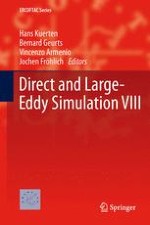2011 | OriginalPaper | Chapter
Regularization modeling of buoyancy-driven flows
Authors : F. X. Trias, A. Gorobets, A. Oliva, R. W. C. P. Verstappen
Published in: Direct and Large-Eddy Simulation VIII
Publisher: Springer Netherlands
Activate our intelligent search to find suitable subject content or patents.
Select sections of text to find matching patents with Artificial Intelligence. powered by
Select sections of text to find additional relevant content using AI-assisted search. powered by
Since direct numerical simulations (DNS) of buoyancy-driven flows cannot be computed at high Rayleigh numbers, a dynamically less complex mathematical formulation is sought. In the quest for such a formulation, we consider regularizations (smooth approximations) of the nonlinear convective term. The first outstanding approach in this direction goes back to Leray (
1934
); the Navier-Stokes-
α
model also forms an example of regularization modeling (see (Geurts and Holm,
2003
), for instance). The regularization methods basically alter the convective terms to reduce the production of small scales of motion. In doing so, we propose to preserve the symmetry and conservation properties of the convective terms exactly. This requirement yields a family of
symmetry-preserving regularization
models (Verstappen,
2008
; Trias et al.,
2010
): a novel class of regularizations that restrain the convective production of smaller and smaller scales of motion in an unconditional stable manner, meaning that the velocity cannot blow up in the energy-norm (in 2D also: enstrophy-norm). In this work, a method to dynamically determine the regularization parameter (local filter length) from the requirement that the vortex-stretching must be stopped at the scale set by the grid is also proposed and tested. The numerical algorithm used to solve the governing equations preserves the conservation properties too (Verstappen, and Veldman,
2003
) and is therefore well-suited to test the proposed simulation model. Here, the performance of the method is tested for a turbulent differentially heated cavity (DHC). Due to the complex behavior exhibit (Trias et al. in International Journal of Heat and Mass Transfer, 53:665,
2010
; Trias et al. in International Journal of Heat and Mass Transfer, 53:674,
2010
) an accurate turbulence modeling of this configuration is as a great challenge.
